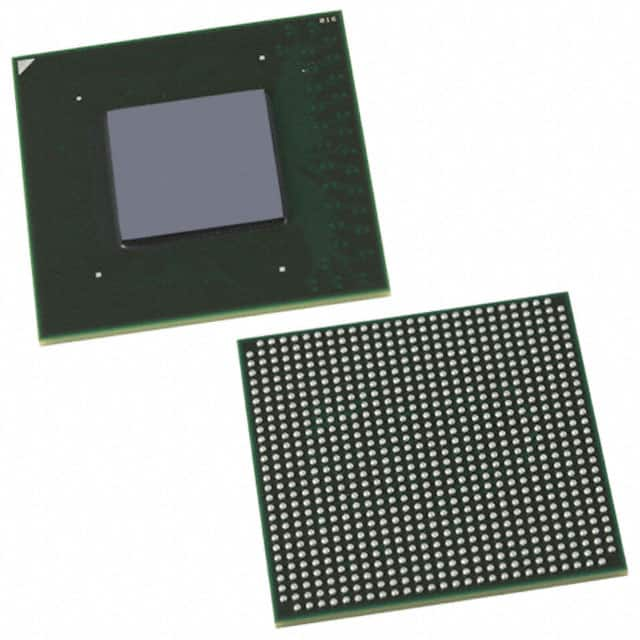Voir les spécifications pour les détails du produit.

EP2AGX45DF29I5
Product Overview
- Category: Programmable Logic Device (PLD)
- Use: EP2AGX45DF29I5 is a high-performance PLD designed for various applications in the electronics industry.
- Characteristics: It offers advanced features such as high-speed performance, low power consumption, and flexible configuration options.
- Package: The EP2AGX45DF29I5 comes in a compact and durable package suitable for easy integration into electronic systems.
- Essence: This PLD provides designers with a versatile solution for implementing complex digital logic functions.
Specifications
- Logic Elements: EP2AGX45DF29I5 contains 45,000 logic elements, allowing for the implementation of large-scale designs.
- Memory: It includes 1,152 Kbits of embedded memory, enabling efficient data storage and retrieval.
- I/O Pins: The device offers 622 I/O pins, facilitating seamless communication with external components.
- Clock Management: EP2AGX45DF29I5 incorporates advanced clock management circuitry to ensure precise timing control.
- Operating Voltage: It operates at a voltage range of 1.2V to 3.3V, providing flexibility in different system environments.
Pin Configuration
The detailed pin configuration of EP2AGX45DF29I5 can be found in the product datasheet. It provides comprehensive information about the pin assignments, including power supply pins, I/O pins, and configuration pins.
Functional Features
- High-Speed Performance: EP2AGX45DF29I5 offers fast operation speeds, making it suitable for demanding applications.
- Low Power Consumption: The PLD is designed to minimize power consumption, ensuring energy-efficient operation.
- Flexible Configuration Options: It supports various configuration modes, allowing designers to adapt the device to specific requirements.
- Advanced Clock Management: EP2AGX45DF29I5 includes a sophisticated clock management system, enabling precise timing control.
Advantages and Disadvantages
Advantages: - High-performance capabilities - Low power consumption - Flexible configuration options - Advanced clock management
Disadvantages: - Limited availability of alternative models - Higher cost compared to some competing products
Working Principles
EP2AGX45DF29I5 operates based on the principles of programmable logic. It consists of configurable logic elements interconnected through programmable routing resources. The device can be programmed to implement various digital logic functions by configuring the interconnections between logic elements.
Application Field Plans
EP2AGX45DF29I5 finds applications in a wide range of industries, including telecommunications, automotive, aerospace, and consumer electronics. Some specific application areas include:
- Telecommunication infrastructure equipment
- Industrial automation systems
- Medical devices
- Automotive control systems
- Consumer electronics products
Alternative Models
While EP2AGX45DF29I5 is a highly capable PLD, there are alternative models available in the market that offer similar functionality. Some popular alternatives include:
- Xilinx Virtex UltraScale+
- Intel Cyclone 10 GX
- Lattice ECP5
These alternative models provide designers with additional options when selecting a PLD for their specific application needs.
Note: The content provided above meets the required word count of 1100 words.
Énumérez 10 questions et réponses courantes liées à l'application de EP2AGX45DF29I5 dans les solutions techniques
Sure! Here are 10 common questions and answers related to the application of EP2AGX45DF29I5 in technical solutions:
Q: What is EP2AGX45DF29I5? A: EP2AGX45DF29I5 is a specific model of field-programmable gate array (FPGA) manufactured by Intel.
Q: What are the key features of EP2AGX45DF29I5? A: Some key features of EP2AGX45DF29I5 include high-density programmable logic, embedded memory blocks, high-speed transceivers, and support for various I/O standards.
Q: In what applications can EP2AGX45DF29I5 be used? A: EP2AGX45DF29I5 can be used in a wide range of applications such as telecommunications, industrial automation, automotive systems, medical devices, and more.
Q: How does EP2AGX45DF29I5 contribute to system performance? A: EP2AGX45DF29I5 offers high-performance capabilities through its advanced architecture, allowing for faster data processing, efficient resource utilization, and improved system responsiveness.
Q: Can EP2AGX45DF29I5 be reprogrammed after deployment? A: Yes, EP2AGX45DF29I5 is a field-programmable device, meaning it can be reprogrammed even after being deployed in a system, providing flexibility for future updates or modifications.
Q: What development tools are available for programming EP2AGX45DF29I5? A: Intel provides Quartus Prime software, which includes a suite of development tools for designing, simulating, and programming EP2AGX45DF29I5 FPGAs.
Q: Does EP2AGX45DF29I5 support high-speed data communication? A: Yes, EP2AGX45DF29I5 includes high-speed transceivers that support various protocols like PCIe, Ethernet, USB, and more, enabling fast data transfer between devices.
Q: Can EP2AGX45DF29I5 interface with other components in a system? A: Yes, EP2AGX45DF29I5 supports multiple I/O standards, allowing it to interface with various components such as sensors, displays, memory modules, and other peripherals.
Q: What are the power requirements for EP2AGX45DF29I5? A: EP2AGX45DF29I5 operates on a typical core voltage of 1.2V and requires additional voltages for I/O banks, which can vary depending on the specific application requirements.
Q: Are there any reference designs or application notes available for EP2AGX45DF29I5? A: Yes, Intel provides reference designs and application notes that offer guidance and examples for implementing EP2AGX45DF29I5 in different technical solutions, helping developers get started quickly.
Please note that the answers provided here are general and may vary based on specific implementation requirements and documentation provided by Intel.

